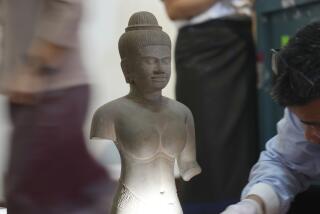Foreign Countries, Firms Help Vietnam Restore Historic Imperial Citadel
- Share via
HUE, Vietnam — Tran Van Luc hops confidently across the rickety wooden scaffold lashed 50 feet up on the roof of the Imperial Theater.
Using a hammer, he smashes a green beer bottle and then carefully picks out a large, jagged shard and fits it into wet cement to form part of a swirling rooftop mosaic.
“We use the Chinese beer bottles for leaves, because the color looks natural,” Luc says, gazing out across the great Citadel of the Vietnamese emperors, a huge complex of classical Chinese-style buildings that have been decaying since suffering through one of the Vietnam War’s biggest battles.
But now that Vietnam’s Communist regime has opened up to the rest of the world, international aid is coming in to help restore the Citadel to its former glory.
“The Citadel is only 200 years old, but it sums up more than 2,000 years of Vietnamese history,” says Thai Cong Nguyen, director of the Monuments and Conservation Committee of Hue, a coastal city about 350 miles south of Vietnam’s capital, Hanoi.
For the Citadel, history climaxed during the Tet Offensive of February 1968, when U.S. Marines and their South Vietnamese allies threw back attacking Communist troops. Four weeks of fighting left dozens of the elegant, elaborately decorated buildings in ruins, and Vietnam’s wet tropical climate attacked everything that was left.
“The frames are rotten, the roofs and drains are falling apart, and fungus, insects and termites are eating the wood,” Nguyen says.
He estimates full restoration will cost about $90 million and take more than a decade.
Designated a World Heritage Site by the United Nations in 1981, the Citadel is drawing help from foreign governments and companies. Japan’s Toyota and France’s Rhone-Poulenc are each paying for work on a building. The U.S. Fulbright program has provided training, and one of Nguyen’s subordinates is studying management at Cornell University in Ithaca, N.Y.
The throne room, or Palace of Supreme Harmony, and several of the Imperial Palace gates have already been rebuilt.
The palace grounds, which occupy about one-tenth of the 4-square-mile Citadel, were spared the worst of the fighting because U.S. and South Vietnamese troops were forbidden to use heavy artillery or air raids there. Still, bullets and mortar fire tore holes in walls, roofs collapsed and some buildings burned down.
The Imperial Theater’s basic structure survived, but the roof frame, tiles and interior are being replaced in a $400,000 project paid for by the French government and Electricite de France, which like other sponsors hopes to gain a foothold as Vietnam’s economy expands.
“Our method is quite different from the Japanese, who send their own experts to do the work,” says Jean-Claude Bernay, a Paris-based construction consultant who visits the site several times a year.
“In Hue they don’t like anyone to come in and tell them what to do, even somebody from Hanoi,” he adds. “It’s Vietnam’s heritage that is being restored. They must be responsible.”
The pace of restoration, both at the Citadel and at Buddhist temples and family shrines elsewhere in Vietnam, has helped revive traditional arts such as mosaics and tile-making.
Luc’s parents are rice farmers, but he had a knack for drawing and an elderly master took him on as an apprentice as mosaics regained popularity.
“The most difficult part is the first step, when you have to imagine the animal or the thing that you start with,” Luc says.
He makes an initial shape in concrete, then lays in pieces of broken china plates, soup bowls and two kinds of beer bottles to give his lion and dragon heads texture and color.
“The quality is not as good as the old things, but we can’t find the material they used in the past,” he says.
Nguyen thinks the Citadel will become Vietnam’s largest tourist attraction, although only about 200,000 foreign visitors arrived last year. A fully restored site would attract 2 million visitors a year, he predicts.
In addition to the foreign money that is coming in, Vietnam’s government is providing $2 million a year and all tourist revenue is plowed back, Nguyen says. Even so, he is looking for more foreign sponsors.
“[In 1995] the Vietnamese and U.S. governments established diplomatic relations,” says Nguyen, a combat veteran who carries deep scars on his face and legs from a U.S. artillery shell. “If the Americans decide to help, nobody can match them.”
More to Read
Sign up for Essential California
The most important California stories and recommendations in your inbox every morning.
You may occasionally receive promotional content from the Los Angeles Times.









